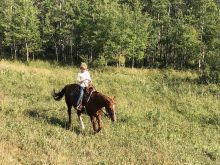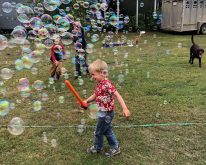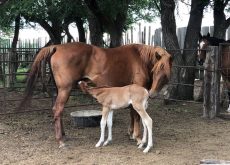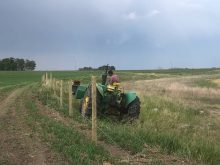You never know what the weather is going to do. Gregory and I had decided that from mid-March to the beginning of May would be the best time for calving season. We didn’t want to calve during the coldest part of the winter with the green grass months away, but we also didn’t want to calve at seeding time. Most years this is a good time to calve, but this year was a little different and provided some challenges.
On March 22 a crazy wind started and lasted several days. The temperature wasn’t bad, but with the wind it was frigid. Then the snow came with the wind. The drifts made it difficult to get from the haystack to the corral. Gregory and John both spent quite a bit of quality time with the snowplow. On the 28th the cold hit us and it set in for about 12 days. We set a few cold temperature records in Saskatchewan during this time.
Read Also

Harvest wraps up and fall work begins
At the Eppich famly ranch in western Saskatchewan, the fall harvest was successful with few breakdowns, cows and calves have been sorted and a new tractor has arrived
We had several calves born during this windy, cold period. We put out a lot of straw and checked the cows more frequently at night so that any newborn calves wouldn’t freeze in between our checks. Thankfully, the cows were good mothers and they licked the calves and got them nursing quickly. We only have two calves with slightly trimmed ears from the frost.
After Easter supper at their daughter’s, John and Barbara got really ill. Eventually Gregory, Joseph, and I all got whatever it was as well. Joseph, thankfully, was only really sick for a day and was back to his old self after a few days, although it took him a little longer to get his appetite back. It took a lot out of us and we have been slow to fully recover.
On April 4th we pulled a large calf out of a Bannerlane heifer. She had no obvious signs that she was in labour, but she was off by herself and looked very uncomfortable. We put her in the calving pen and gave her some time. A little while later she was lying down and straining. She got up and we couldn’t see anything: no bag of fluids, no feet, nothing. We watched her a little longer, and then knew we had to act fast when she laid out flat straining with nothing to show for her efforts. We worked together and pulled the calf. It was positioned properly, but it was big. We got it pulled just in time and the calf was alive. It was such a long and stressful birth that the calf had been oxygen-deprived, however. The calf had no suck reflex so we ended up tubing it three times a day for a couple of days. Eventually it got stronger and we were able to help it onto the heifer. After four days of continuous help, the calf finally started nursing on its own.
On April 18 we got together with the neighbours and butchered two bulls: one of theirs and one of ours. Our butcher bull was actually the first calf born last year and is part of the first calf crop that Gregory and I have raised together. It is amazing how time seems to pass so quickly.
















